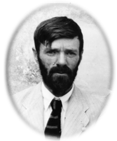Definition
Paradox is a statement, proposition, or situation that seems to be absurd or contradictory, but in fact is or may be true.Etymology
The English term paradox was borrowed during the mid-16th century from the Late Latin noun paradoxum, which the Latin speakers adopted from the Greek adjective paradoxos meaning "contrary to expectation" which was combined from Greek prefix para- "contrary to" + doxa "opinion," the latter derived from dokein "to appear, to seem, to think, to accept".Derivatives
adj. Paradoxical
adv. Paradoxically
Discussion
Paradox is a literary device wherein two seemingly contrasting ideas or statements are juxtaposed. A paradox may seem like a self-contradictory, silly statement at first, but upon further analysis, it will reveal a latent truth. Therefore, paradox consists of two levels:- Basic/surface level: the function of surface level is to conceal the rational meaning of a statement.
- Higher/deeper level: the function of higher level is to reveal the actual truth behind a statement.
“Failure is the pillar of success.”
Function
- Paradox helps develop reader's creativity by compelling them to ponder over a subject in an innovative way.
- Paradox is employed to create unconventional imagery.
- Authors use paradox to draw reader's attention.
- Paradox makes the text more interesting.
- Paradoxical statements often sum up the main ideas of the work.
Classification
Paradoxes could be categorized into the following ways:- Rhetorical Paradox: rhetorical paradox is a seemingly contrasting comment or statement made by a character. A well-known example of paradox appears in George Orwell’s Animal Farm (1945):
“All animals are equal, but some are more equal than others”.
- Situational Paradox: situational paradox is a situation or circumstance that is contradictory. The following passage from Joseph Heller’s novel Catch-22 (1961) consists of an instance of situational paradox:
“There was only one catch and that was Catch-22, which specified that a concern for one’s safety in the face of dangers that were real and immediate was the process of a rational mind. Orr was crazy and could be grounded. All he had to do was ask; and as soon as he did, he would no longer be crazy and would have to fly more missions.”
Paradox vs. Oxymoron
| Sl. # | Paradox | Oxymoron |
| Paradox may consist of a sentence or even a group of sentences. | Oxymoron is a combination of two contradictory or opposite words. | |
| Paradox refers to actual conditions or concepts which appear to present an impossible situation. | Oxymoron refers to word combinations which are contradictory. | |
| Paradox arrests attention and provokes innovative thought. | Oxymoron creates a dramatic effect. | |
| Paradox is not solely a witty or amusing statement, often it can prove to be very revealing about human nature and the way that we speak. | Oxymoron is just the juxtaposition of two words for amusement. | |
| Paradox can be created using an oxymoron. | Oxymoron can be used to create a paradox. |
References
“Difference Between Paradox and Oxymoron.” Pediaa.Com. 2016. Pediaa.Com. 4 November 2016
< http://pediaa.com/difference-between-paradox-and-oxymoron/>.
“Examples of Paradox.” Your Dictionary. 2016. LoveToKnow, Corp. 4 November 2016
< http://pediaa.com/difference-between-paradox-and-oxymoron/>.
“Paradox.” Wikipedia.com. 2016. Wikimedia Foundation, Inc. 4 November 2016
< https://en.wikipedia.org/wiki/Paradox >.
“Paradox.” Literary Devices. 2016. Literary Devices. 4 November 2016
< http://literarydevices.net/paradox/>.























